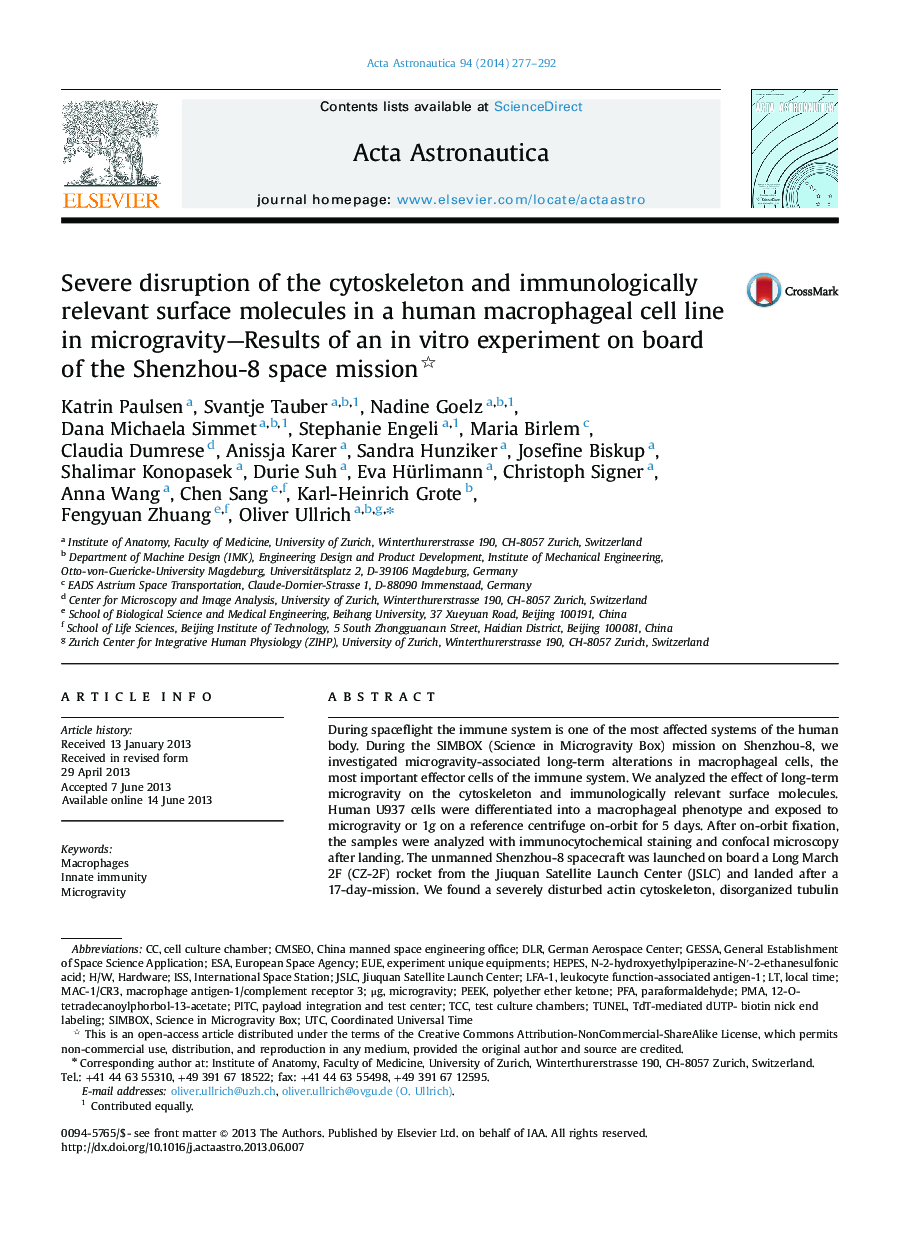| کد مقاله | کد نشریه | سال انتشار | مقاله انگلیسی | نسخه تمام متن |
|---|---|---|---|---|
| 10680837 | 1013344 | 2014 | 16 صفحه PDF | دانلود رایگان |
عنوان انگلیسی مقاله ISI
Severe disruption of the cytoskeleton and immunologically relevant surface molecules in a human macrophageal cell line in microgravity-Results of an in vitro experiment on board of the Shenzhou-8 space mission
دانلود مقاله + سفارش ترجمه
دانلود مقاله ISI انگلیسی
رایگان برای ایرانیان
کلمات کلیدی
PFAPITCμgH/WLFA-1TCCEUEDLRISSESA12-O-tetradecanoylphorbol-13-acetateUTCHEPESPMA - LDC هاN-2-hydroxyethylpiperazine-N′-2-ethanesulfonic acid - N-2-hydroxyethylpiperazine-N'-2-ethanesulfonic acidleukocyte function-associated antigen-1 - آنتی ژن 1 مرتبط با عملکرد لکوسیتEuropean Space Agency - آژانس فضایی اروپاInternational space station - ایستگاه فضایی بین المللیInnate immunity - ایمنی ذاتیTUNEL - تونلMicrogravity - ریزگرانش یا میکروگرانشLocal time - زمان محلیPEEK - زیرچشمی نگاه کردنHardware - سخت افزارMacrophages - ماکروفاژها،درشت خوارهاGerman aerospace center - مرکز هوافضایی آلمانparaformaldehyde - پارافرمالدهیدSpaceflight - پرواز فضاییpolyether ether ketone - پلی اتر اتر کتون
موضوعات مرتبط
مهندسی و علوم پایه
سایر رشته های مهندسی
مهندسی هوافضا
پیش نمایش صفحه اول مقاله

چکیده انگلیسی
During spaceflight the immune system is one of the most affected systems of the human body. During the SIMBOX (Science in Microgravity Box) mission on Shenzhou-8, we investigated microgravity-associated long-term alterations in macrophageal cells, the most important effector cells of the immune system. We analyzed the effect of long-term microgravity on the cytoskeleton and immunologically relevant surface molecules. Human U937 cells were differentiated into a macrophageal phenotype and exposed to microgravity or 1g on a reference centrifuge on-orbit for 5 days. After on-orbit fixation, the samples were analyzed with immunocytochemical staining and confocal microscopy after landing. The unmanned Shenzhou-8 spacecraft was launched on board a Long March 2F (CZ-2F) rocket from the Jiuquan Satellite Launch Center (JSLC) and landed after a 17-day-mission. We found a severely disturbed actin cytoskeleton, disorganized tubulin and distinctly reduced expression of CD18, CD36 and MHC-II after the 5 days in microgravity. The disturbed cytoskeleton, the loss of surface receptors for bacteria recognition, the activation of T lymphocytes, the loss of an important scavenger receptor and of antigen-presenting molecules could represent a dysfunctional macrophage phenotype. This phenotype in microgravity would be not capable of migrating or recognizing and attacking pathogens, and it would no longer activate the specific immune system, which could be investigated in functional assays. Obviously, the results have to be interpreted with caution as the model system has some limitations and due to numerous technical and biological restrictions (e.g. 23 °C and no CO2 supply during in-flight incubation). All parameter were carefully pre-tested on ground. Therefore, the experiment could be adapted to the experimental conditions available on Shenzhou-8.
ناشر
Database: Elsevier - ScienceDirect (ساینس دایرکت)
Journal: Acta Astronautica - Volume 94, Issue 1, JanuaryâFebruary 2014, Pages 277-292
Journal: Acta Astronautica - Volume 94, Issue 1, JanuaryâFebruary 2014, Pages 277-292
نویسندگان
Katrin Paulsen, Svantje Tauber, Nadine Goelz, Dana Michaela Simmet, Stephanie Engeli, Maria Birlem, Claudia Dumrese, Anissja Karer, Sandra Hunziker, Josefine Biskup, Shalimar Konopasek, Durie Suh, Eva Hürlimann, Christoph Signer, Anna Wang, Chen Sang,